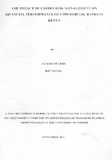The impact of credit risk management on financial performance of commercial banks in Kenya

View/
Date
2011-11Author
Oludhe, Jackson
Type
ThesisLanguage
enMetadata
Show full item recordAbstract
The objective of this study was to analyze the impact of credit risk management on the financial performance and to establish if there exists any relationship between the credit risk management determinants by use of CAMEL indicators and financial performance of commercial banks in Kenya. A causal research design was undertaken in this study and this was facilitated by the use of secondary data which was obtained from the CBK publications on banking sector survey. The study used multiple regression analysis in the analysis of data and the findings have been presented in the form of tables and regression equations. The study also found that there is a strong impact between the CAMEL components on the financial performance of commercial banks with the R2 values being lowest at 0.594 in 2007 and highest at 0.943 in 2009 implying that in 2007 CAMEL components could explain 59.4 percent variations in financial performance and 94.3 percent variations in financial performance in 2009. The study also established that capital adequacy, asset quality, management efficiency and liquidity had weak relationship with financial performance (ROE) whereas earnings had a strong relationship with financial performance. This study concludes that CAMEL model can be used as a proxy for credit risk management. The study thus recommends that commercial banks should also try to keep their operational cost low as this negates their profits margin thus leading to low financial performance. This is depicted by the strong effect of earnings on financial performance.
Citation
MBA ThesisSponsorhip
University of NairobiPublisher
School of Business, University of Nairobi
Description
The impact of credit risk management on financial performance of commercial banks in Kenya
